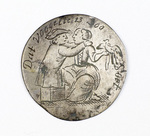Decorated with Love
#SUBHEADING#Love Tokens#SUBHEADINGEND# Love tokens were a way of letting someone know your intentions without saying the words out loud. Love tokens were usually hand made and simple in design but highly decorative. During the 18th and 19th century coins were used as love tokens. They were handmade by suitors who gave them to their sweethearts. Poorer working class young men made their tokens from copper coins; wealthy young men used silver or even a gold coin. #IMAGE# Love tokens sometimes consisted of a coin which had been worn away on both sides by a young man. The blank discs were then engraved with the man's name or his sweethearts name with decoration such as hearts and bows and arrows. These love tokens were made by often illiterate unskilled men so it's remarkable how decorative they were. They are found often by metal detectors but whether they were lost of thrown away by the lady it is uncertain. #SUBHEADING#Pin Cushion#SUBHEADINGEND##IMAGE# This heart shaped decorative pin cushion, marked 'East Yorkshire Regiment XV, battle honours in surrounding wreath at Wilberforce museum. The cushion had been sent by a soldier in the First World War to his sweetheart. The cushion consists of a copper coloured border, blue pins, and pink ribbons with printed sayings, pink rose border and blue back. #SUBHEADING#Romance and Scrimshaw#SUBHEADINGEND# Scrimshaw is the creation of handiwork by whalers made from the by products of harvesting marine mammals. It is generally made out of bone and teeth of sperm whales, the baleen of other whales, and the tusks of walruses. It takes the form of elaborate carving in the form of pictures and lettering on the surface of the bone or tooth, with the engravings highlighted using a pigment of lamp black or India ink.The making of scrimshaw began on whaling ships around 1817 to 1824 and survived until the ban on commercial whaling. Hull seamen used Baleen and walrus tusks. They were lovingly carved with suitable pictures and words of endearments for their wives or sweethearts. The museum collections include two snuff boxes made from horn and cedar wood with romantic inscriptions including 'either love mee or love mee not'. whilst a second bearing the date of 1712 says 'Lend mee not if you love mee'. #SUBHEADING#Knitting Sheaths and love#SUBHEADINGEND# Knitting sheaths were given as love tokens in the same way as welsh spoons. Some were elaborately carved by a suitor and given to his sweetheart. The knitting sheaths did serve a practical purpose and would be worn on the right side of the body at an angle. In the sheath would be placed the end of the knitting needle, leaving the left hand to work the yarn on the other needle.#IMAGE#The sheath was supposed to hold the weight of the wool, thus preventing the hooks from falling of the end of the knitting needles.The collections include two knitting sheaths featuring hearts in-laid in the wooden handle. One of the sheaths even has a scroll curled end in the shape of a heart with a small 'window' in which a love message could be written on paper and inserted.
 The History of Valentine Day
The History of Valentine Day
Hull Museums have a large collection of Valentine's Cards and other objects associated with Valentines but where did the tradition originate? The history of Valentine's Day is surrounded in mystery, though February has always been the month of romance. St Valentine's Day contains both Christian and ancient Roman tradition.
 Love survives in our Museum's
Love survives in our Museum's
Our museums in Hull have a large collection of objects relating to Valentine, love, romance and affection. These objects are varied and can be found across our museums in our galleries ranging from Art, photography, sculpture, tokens, cards and knitting sheaths. Read on to discover the love and romance in Hull Museums






